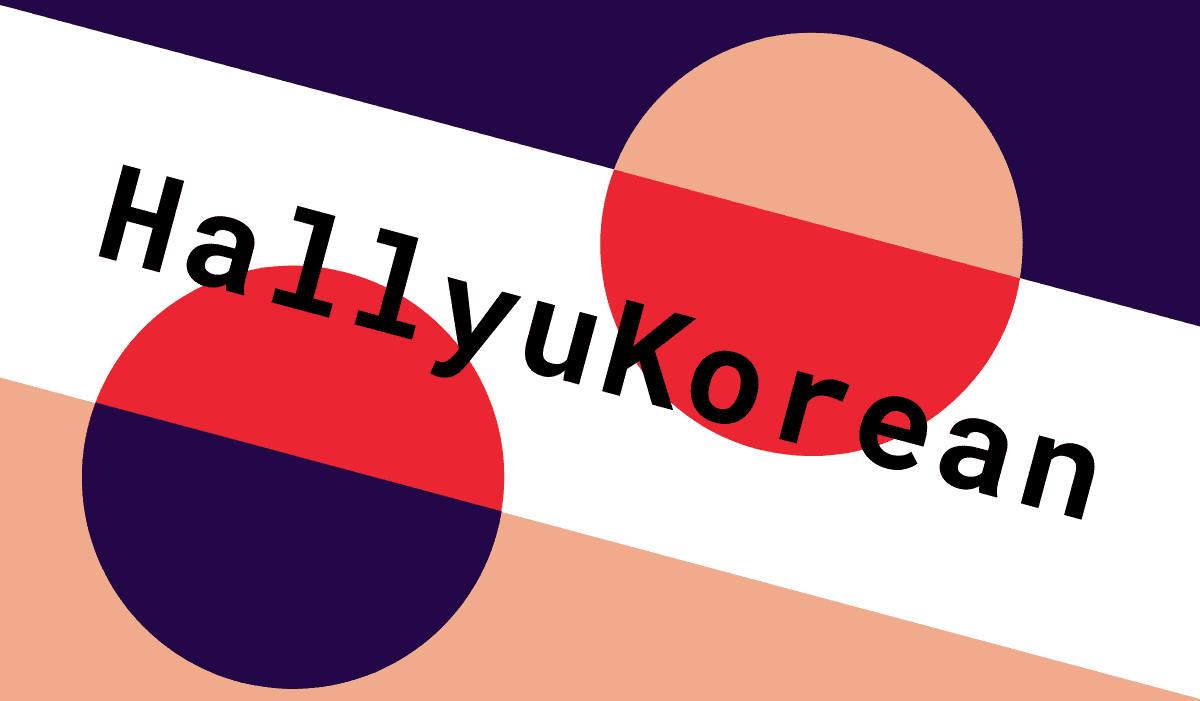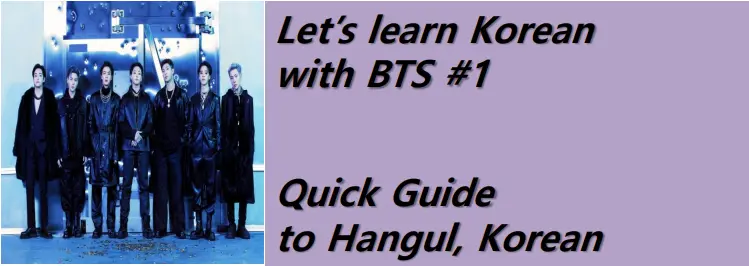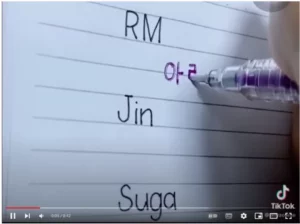Quick Guide to Hangul, Korean
We will learn the most frequently used Korean words in BTS lyrics and this quick guide will help you understand the basics of Korean.
Korean uses its own unique alphabet called Hangul.
Hangul consists of 10 vowels and 14 consonants, making a total of 24 basic characters.

All Hangul words are made up of syllable(s) and Hangul has the following basic rules:
● A syllable starts with a consonant.
● A syllable has at least 1 consonant and 1 vowel.
(initial consonant + middle vowel + (optional final consonant))
● Hangul is written from top to bottom, from left to right.
Vowels
There are 10 basic characters in vowels. These vowels will appear in every single syllable of Hangul.
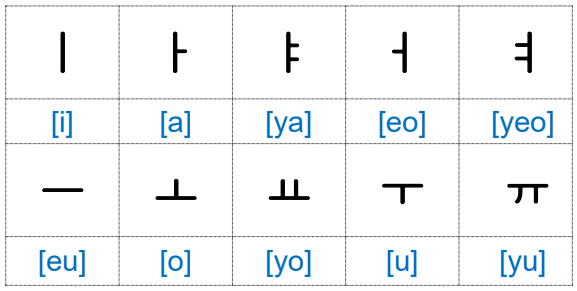
● Vowels with a long vertical line: ㅣ, ㅏ, ㅑ, ㅓ, ㅕ
These vertical vowels always have a consonant to the left
● Vowels with long horizontal line: ㅡ, ㅗ, ㅛ, ㅜ, ㅠ
These horizontal vowels always have a consonant above them.
No Korean vowel can stand alone at the beginning of a Hangul syllable without a preceding consonant, but if it has no consonant sound value of its own, it must be preceded by the consonant ‘ㅇ’, which is silent when placed at the beginning of a syllable and ‘ㅇ’ acts as a placeholder.
11 additional vowel characters can be created by combining the above 10 basic characters.
Consonants
There are 14 basic characters in consonants.
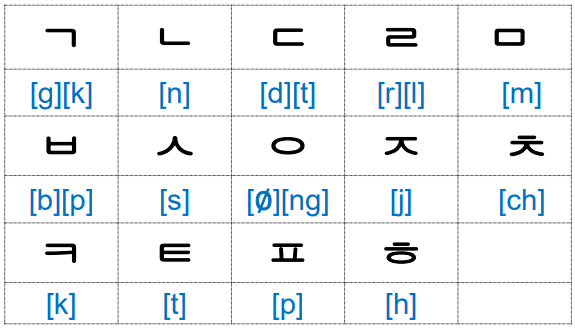
• The consonant ‘ㅇ’ has no sound as an initial consonant and [ng] sound as a final consonant.
• ㄱ, ㅋ, ㄲ : Their shape is slightly changed with the vertical vowels such as 가, 카, 까.
The pronunciations of each consonant above apply when the consonant is used as a beginning consonant. When these consonants are used as final consonants, only 7 consonants ㄱ, ㄴ, ㄷ, ㄹ, ㅁ, ㅂ, ㅇ are pronounced and the rest of the consonants are pronounced as one of these 7 consonants.
There are 5 more double consonants(ㄲ, ㄸ, ㅃ, ㅆ, ㅉ) and complex final consonants.
Hangul Syllable and Character Block Types
There are 9 possible character block types to form a Hangul syllable. At least 2 characters are written in each type, and each block represents one syllable. The diagram below shows all possible character block types.

• Type 1~2: The most common combination of consonant and vowel
• Type 3: Consonant + 2 vowels (horizontal vowel + vertical vowel)
• Type 4~6: Optional final consonant added to type 1~3
• Type 7~9: Complex final consonants added to type 1~3
For more information, the YouTube channel below(Learn Korean with KoreanClass101.com) can help you learn the Korean alphabet and language.
Korean Alphabet – Learn to Read and Write Korean Hangul
BTS members’ names in Hangul(RM, Jin, SUGA, j-hope, Jimin, V, Jung Kook)
Let’s learn the Hangul vowels, consonants and syllables using the BTS members’ stage names (RM, Jin, SUGA, j-hope, Jimin, V, Jung Kook) in Hangul.
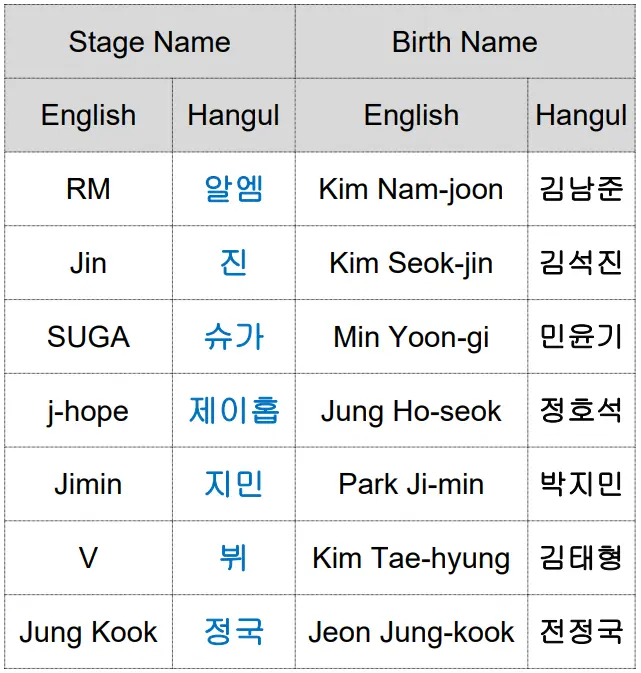
If you divide the stage names (RM, Jin, SUGA, j-ope, Jimin, V, Jung Kook) into consonants and vowels according to the order in which they are written, you can see that each syllable belongs to type 1~5. Please note that each character within the character block has a sound and forms a syllable.
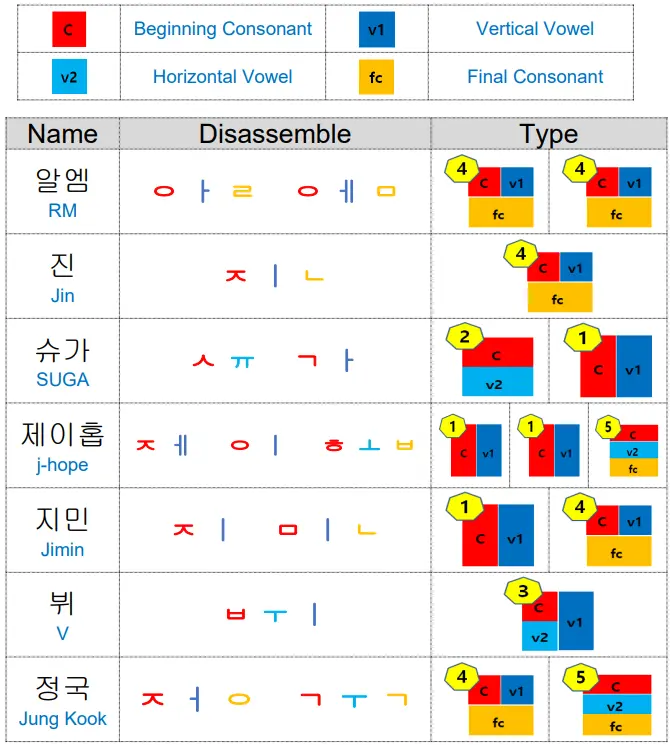
In Hangul, all characters are written from left to right and from top to bottom. Let’s practise with stage names (RM, Jin, SUGA, j-hope, Jimin, V, Jung Kook).
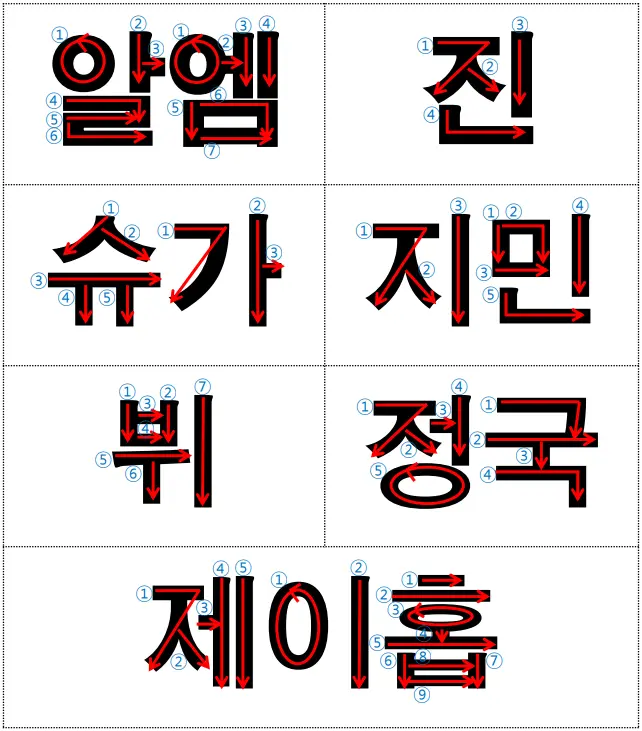
For more information, the YouTube channel below will help you write the names of the BTS members in Korean.
What makes Korean so different from English?
Word order is important for understanding English sentences, while particles(e.g. 은/는/이/가/을/를) are important for understanding Korean sentences.
It is important to note that in Korean the verb is at the end of the sentence, which is different from the order in English.
Once you have heard the verb, you need to identify what kind of grammar it uses. For example, is it in the past, present or future tense? Is it a question, an order or a statement?
Even Koreans say, “You have to listen to the end to understand Korean,” because the verb comes at the end of the sentence and the whole meaning of the sentence can be changed by the verb.
It’s also important to note that while English sentences require a subject, Korean sentences often omit the subject.
Korean verb conjugation
Korean verbs are conjugated using the verb stem, dictionary form, and informal polite form.
Korean verb dictionary form
The dictionary form is what you would look up in a Korean dictionary. It’s like English infinitives, to go, to eat. And all dictionary forms of Korean verbs end with -다.
ex)가다, 괜찮다
Korean verb stem
Just remove the -다 at the end of the dictionary form.
ex)가 is the verb stem of 가다, 괜찮 is the verb stem of 괜찮다
Note that these verb stems are never used alone.
Informal polite Korean
하다(hada, to do) is the dictionary form and there are several conjugations of 하다 in Korean.
1)해라(haera) 2)해(hae) 3)해요(haeyo) 4)하십시오(hasipsio)
해요, 해 are informal and are usually used in everyday conversation.
The politeness level is 1 < 2 < 3 < 4.
Using -요 at the end of verbs shows respect for the people you are talking to.
For example, 가요 is the informal polite form of 가다, 괜찮아요 is the informal polite form of 괜찮다.
Korean sentence structures
This table provides a simplified comparison of declarative sentence structure between Korean and English. It is important to note that actual sentence structures may vary depending on the complexity and context of the sentence. However, this table provides a general overview of the differences in sentence structure between the two languages.
| English | Example | Korean | Example | |
| Type 1 | S+V | I run | S+V | 나는 달려 |
| Type 2 | S+V+C | I am a student | S+C+V | 나는 학생이야 |
| Type 3 | S+V+O | I love you | S+O+V | 나는 너를 사랑해 |
| Type 4 | S+V+IO+DO | I gave him an apple | S+IO+DO+V | 나는 그에게 사과를 주었어 |
| Type 5 | S+V+O+C | You make me happy | S+O+C+V | 너는 나를 행복하게 해 |
